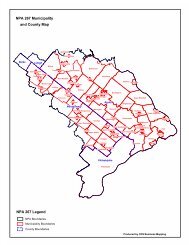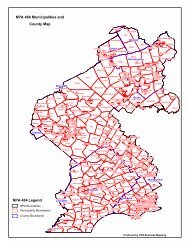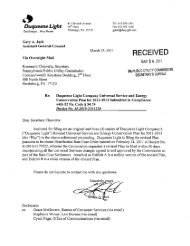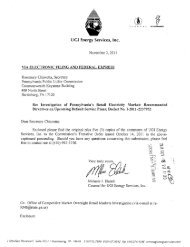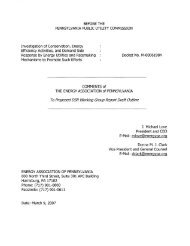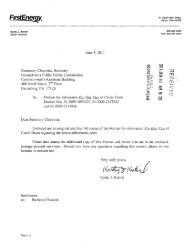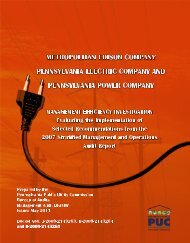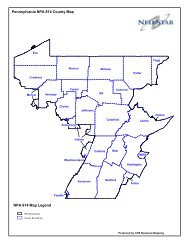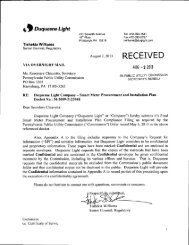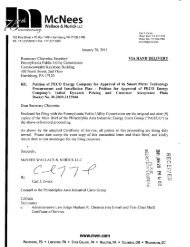Section 2 – Historic and Forecast Data2009: A Year in Review<strong>Pennsylvania</strong>’s aggregate electricity sales in 2009 totaled 142,161 gigawatthours (GWh), 48 a 4.2percent decrease from that of 2008, while the number of customers increased by 0.35 percent.This decrease was evident in all retail customer groups except “other” and follows a 0.5 percentdecrease in sales from 2007 to 2008. Industrial sales declined 9.2 percent. Residential salesrepresented 35.4 percent of the total sales, followed by commercial (31.7 percent) and industrial(30.3 percent). Aggregate non-coincident peak load 49 decreased to 27,597 MW in 2009, down 8.2percent from 2008. Tables 5 and 6 provide statistics for 2009, and 2008 for comparison.Table 5 PA EDCs' energy demand, peak load and customers served (2009)Total Sales For Total System Company Net Energy PeakCustomers Residential Commercial Industrial Other Resale Consumption Losses Use For Load LoadCompany Served (MWh) (MWh) (MWh) (MWh) (MWh) (MWh) (MWh) (MWh) (MWh) (MW)Duquesne 586,616 3,945,655 6,537,414 2,616,153 64,351 21,849 13,185,422 662,150 30,441 13,878,013 2,732Met-Ed 551,283 5,448,240 4,568,227 3,438,601 34,487 0 13,489,555 895,908 13,633 14,399,096 2,739Penelec 589,959 4,471,133 5,018,687 4,044,173 41,421 0 13,575,414 773,805 4,347 14,353,566 2,451Penn Power 159,692 1,634,012 1,366,828 1,228,844 6,464 1,018 4,237,166 128,641 1,970 4,367,777 901PPL 1,398,461 14,218,100 13,817,800 8,417,700 237,000 931,937 37,622,537 2,475,685 69,656 40,167,878 6,845PECO 1,564,433 12,893,426 8,404,059 15,888,955 927,616 587,586 38,701,642 2,010,187 45,420 40,757,249 7,994West Penn 714,974 7,100,611 4,880,026 7,285,694 49,114 739,915 20,055,360 1,118,642 -- 21,174,002 3,667UGI 62,166 518,028 328,583 102,981 5,603 92 955,287 53,569 1,912 1,010,768 193Citizens' 6,814 79,818 27,487 52,237 667 0 160,209 7,205 190 167,604 39Pike County 4,649 28,077 44,699 0 404 0 73,180 4,954 17 78,151 15Wellsboro 6,133 40,171 31,051 33,600 229 130 105,182 9,106 300 114,587 21Total 5,645,180 50,377,271 45,024,861 43,108,938 1,367,356 2,282,527 142,160,954 8,139,852 167,886 150,468,691 27,597% of Total 35.44% 31.67% 30.32% 0.96% 1.61% 100.00%2009 v 2008 0.35% -1.84% -1.86% -9.17% 1.82% -1.76% -4.16% -8.73% -2.76% -4.42% -8.16%Table 6 PA EDCs' energy demand, peak load and customers served (2008)Total Sales For Total System Company Net Energy PeakCustomers Residential Commercial Industrial Other Resale Consumption Losses Use For Load LoadCompany Served (MWh) (MWh) (MWh) (MWh) (MWh) (MWh) (MWh) (MWh) (MWh) (MW)Duquesne 586,804 4,060,410 6,631,217 3,079,488 66,811 22,708 13,860,634 963,150 30,222 14,854,006 2,822Met-Ed 549,486 5,597,600 4,776,548 3,831,118 35,467 0 14,240,733 961,231 13,270 15,215,234 3,045Penelec 589,552 4,557,862 5,185,820 4,593,995 41,574 0 14,379,251 881,122 4,804 15,265,177 2,880Penn Power 159,585 1,666,785 1,404,034 1,614,208 6,466 4,348 4,695,841 154,133 1,968 4,851,942 1,063PPL 1,394,202 14,418,614 13,912,558 9,551,368 225,891 981,726 39,090,157 2,665,912 72,806 41,828,875 7,316PECO 1,570,294 13,317,085 8,700,237 16,533,639 908,982 554,752 40,014,695 1,941,212 47,774 42,003,681 8,824West Penn 713,409 7,172,183 4,925,027 8,134,755 52,001 759,876 21,043,842 1,300,129 -- 22,343,971 3,823UGI 62,262 530,174 344,039 122,861 5,658 91 1,002,823 52,016 1,809 1,056,648 197Citizens' 6,791 82,710 29,015 55,820 713 0 168,258 4,411 190 172,859 41Pike County 4,642 29,321 47,765 0 208 0 77,293 300 9 77,602 19Wellsboro 6,014 41,382 33,377 35,304 231 152 110,446 7,726 277 118,449 21Total 5,625,594 51,320,713 45,879,480 47,461,432 1,342,850 2,323,501 148,327,976 8,918,905 172,653 157,419,534 30,050% of Total 34.60% 30.93% 32.00% 0.91% 1.57% 100.00%Between 1994 and 2009, the state’s energy demand grew at an average rate of 1.0 percentannually. Residential sales grew at an annual rate of 1.5 percent and commercial at 2.1 percent;48 A GWh is equivalent to 1,000 MWh or 1,000,000 kWh.49 Non-coincident peak load is the sum of EDCs’ annual peak loads regardless of their date or time of occurrence.20<strong>Pennsylvania</strong> <strong>Public</strong> <strong>Utility</strong> <strong>Commission</strong>
industrial sales declined at an average rate of 0.4 percent per year, due mainly to a 9.4 percent dropin 2009. Over the past five years, residential demand increased an average of 0.9 percent per yearand commercial at 1.0 percent; industrial sales decreased a total of 8.3 percent. Average annualtotal sales growth from 2004 to 2009 was 0.1 percent.The current aggregate five-year projection of growth in energy demand is 1.4 percent. Thisincludes a residential growth rate of 0.9 percent, a commercial rate of 1.9 percent and an industrialrate of 1.6 percent. See Figure 9, which depicts growth in retail energy demand by sector, in GWh.Figure 9 <strong>Pennsylvania</strong> aggregate energy demand (GWh)53,500HistoricForecasts51,50049,500CommercialResidential47,50045,50043,500Industrial41,50039,50037,5002000 2001 2002 2003 2004 2005 2006 2007 2008 2009 <strong>2010</strong> 2011 2012 2013 2014Over the past 15 years, the average aggregate non-coincident peak load for the major EDCsincreased 0.7 percent per year. From 2004 to 2009, the peak load increased by an average of 0.4percent per year. From 2008 to 2009, the aggregate peak load dropped 2,453 MW from 30,050MW to 27,597 MW, or an 8.2 percent decrease. The 2009 summer peaks occurred in August.The combined forecast of the EDCs’ peak load shows the load increasing from 27,597 MW in2009 to 29,550 MW in 2014 at an average annual growth rate of 1.4 percent. Actual peak loadsare weather adjusted to reflect normal weather conditions prior to applying forecastingmethodologies. Thus, the projected growth rates reflect the year-to-year fluctuations in energysales and peak load.Projections of energy demand and peak load reflect EDC compliance with the requirements of Act129 relating to energy efficiency and demand response options available for each customer class.See Figure 10.Electric Power Outlook for <strong>Pennsylvania</strong> 2009-2014 21



